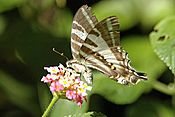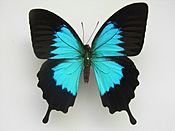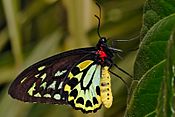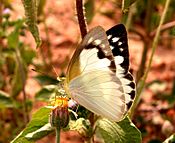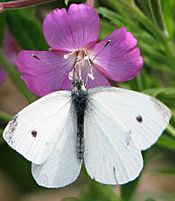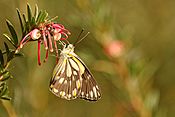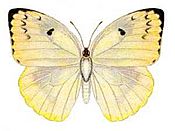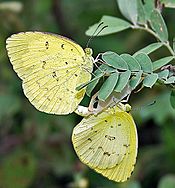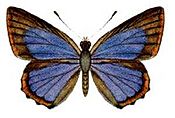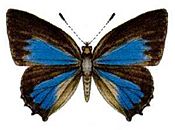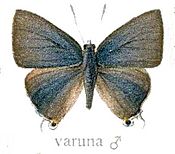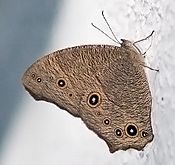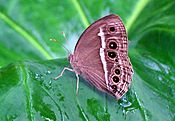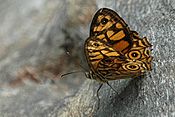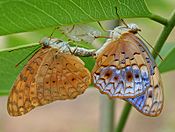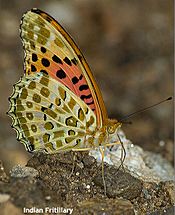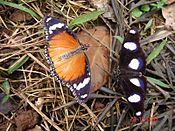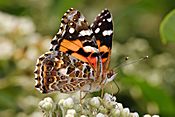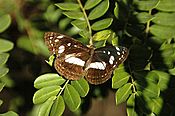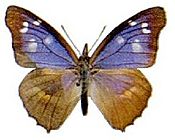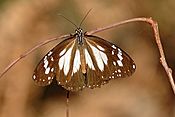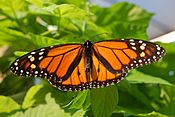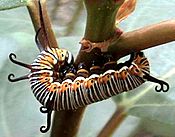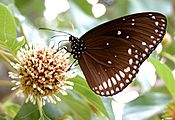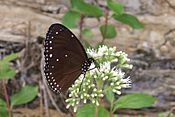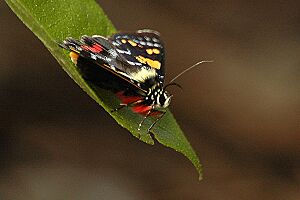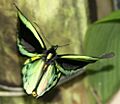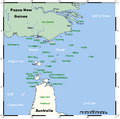List of butterflies of Australia facts for kids
Australia is home to over 400 different types of butterflies! Most of these live on the mainland, but some special ones are found only on remote islands that are part of Australia. The biggest butterflies in the world, called birdwings, live in the Australasian region. They are part of the swallowtail butterfly family.
Contents
Amazing Swallowtail Butterflies
The swallowtail butterfly family, known as Papilionidae, includes 18 species found in Australia, plus two more that live on islands. These butterflies are often large and colorful, with some having "tails" on their hindwings.
Papilioninae
This group includes many well-known butterflies.
- The Four-barred swordtail (Protographium leosthenes) is a striking butterfly with black and white stripes.
- The Blue triangle (Graphium sarpedon) is famous for its bright blue markings.
- The Orchard swallowtail (Papilio aegeus) is a common sight in gardens.
- The Ulysses swallowtail (Papilio ulysses) is known for its brilliant blue wings.
- The Cairns birdwing (Ornithoptera euphorion) is Australia's largest butterfly, with males having stunning green and black wings. The Richmond birdwing is another beautiful species.
- The Clearwing swallowtail (Cressida cressida) has wings that are partly see-through.
- The Red-bodied swallowtail (Pachliopta polydorus) has a unique red body.
- Some swallowtails, like the Christmas swallowtail (Papilio memnon) and Norfolk swallowtail (Papilio amynthor), are found only on Christmas Island and Norfolk Island, respectively.
White and Yellow Butterflies
The Pieridae family includes butterflies that are mostly white or yellow. Australia has 35 species in this family, plus two more on islands and one introduced species.
Pierinae: Whites
This group includes many common white butterflies.
- The Black-spotted white (Leptosia nina) is a small, delicate butterfly.
- The White albatross (Appias albina) is a common white species. Other albatrosses include the Orange, Blue, Grey, Yellow, and Striped albatross.
- The Small cabbage white (Pieris rapae) is an introduced species in Australia, meaning it was brought here from another country.
- The Caper white (Belenois java) is known for its large migrations.
- The Caper gull (Cepora perimale) is another white butterfly.
- The Jezebels (Delias genus) are known for their bright colors, often red and yellow, on the underside of their wings. Examples include the Scarlet Jezebel, Red-banded Jezebel, Spotted Jezebel, Golden Jezebel, Yellow-banded Jezebel, Imperial Jezebel, Black Jezebel, and Yellow-spotted Jezebel.
Coliadinae: Yellows
This group features many yellow butterflies.
- Migrants (Catopsilia genus) are often seen flying long distances. They include the White migrant, Lemon migrant, Orange migrant, and Yellow migrant.
- Grass-yellows (Eurema genus) are smaller, bright yellow butterflies. Some examples are the No-brand grass-yellow, Lined grass-yellow, Pink grass-yellow, Small grass-yellow, Broad-margined grass-yellow, Scalloped grass-yellow, and Large grass-yellow. The Three-spot grass yellow is found on Christmas and Darnley Islands.
Sparkling Metalmark Butterflies
The Riodinidae family, or metalmarks, has only one species in Australia.
Nemeobiinae
- The Harlequin metalmark (Praetaxila segecia) is the single metalmark species found in Australia. It has a unique pattern on its wings.
Blue and Copper Butterflies
The Lycaenidae family is very large, with 142 species in Australia, plus seven more on islands. These butterflies are often small and have shimmering blue or copper colors.
Miletinae: Harvesters
- The Moth butterfly (Liphyra brassolis) is a unique species in this group, known for its moth-like appearance.
Theclinae: Hairstreaks
Hairstreaks often have tiny tails on their hindwings.
- The Chequered copper (Lucia limbaria) and Purple copper (Paralucia spinifera) are beautiful copper-colored butterflies.
- Ant-blues (Acrodipsas genus) are special because their caterpillars live in ant nests! Examples include Illidge's ant-blue and Grey ant-blue.
- Jewels (Hypochrysops genus) are known for their bright, metallic colors. Some are the Yellow jewel, Mangrove jewel, Turquoise jewel, and Narcissus jewel.
- Moonbeams (Philiris genus) are often blue or purple.
- Oak-blues (Arhopala genus) are found near oak trees.
- Azures (Ogyris genus) are another group of blue butterflies.
- Hairstreaks (Jalmenus and Pseudalmenus genera) are known for their delicate tails.
- Flashes (Hypolycaena, Deudorix, Rapala, and Bindahara genera) are fast-flying butterflies. The Dark cornelian and Indigo flash are examples.
Polyommatinae: Blues
This is a very large group of small, often blue butterflies.
- Pencil-blues and Dusky-blues (Candalides genus) are common.
- Opals (Nesolycaena genus) are named for their shimmering appearance.
- Ciliate-blues (Anthene genus) have tiny hairs on their wing edges.
- Line-blues (Nacaduba, Erysichton, Prosotas, Catopyrops, Ionolyce, Sahulana genera) are a diverse group. Some, like the Violet line-blue and Bold line-blue, are found on Torres Strait Islands.
- Green-banded blues (Danis and Psychonotis genera) have distinct green bands. The Dark green-banded blue is found on Murray Island.
- Heath-blues (Neolucia genus) live in heathlands.
- Ceruleans (Jamides genus) are often a beautiful blue color. The King cerulean is found on Christmas Island, and the Papuan cerulean on Darnley Island.
- Pea-blues (Catochrysops and Euchrysops genera) are small and often found near pea plants. The Long-tailed pea-blue is well-known.
- Grass-blues (Zizeeria, Zizina, Famegana, Zizula, Everes, Freyeria genera) are very common in grassy areas. The Common grass-blue is one of the most widespread butterflies in Australia. The Lesser grass-blue is found on Christmas Island.
- Pied blues (Pithecops and Megisba genera) have a patchy color pattern.
- The Delicate blue (Udara tenella) is a tiny, fragile butterfly.
Brush-Footed Butterflies
The Nymphalidae family, also called brush-footed or four-footed butterflies, is another large group with 81 species in Australia, plus six more on islands. Their front legs are smaller and brush-like, so they often appear to walk on only four legs.
Morphinae
- Owls (Taenaris genus) are known for their large eye-spots on their wings, which look like owl eyes. The Pearl owl and Silky owl are examples. The Silky owl is found on Saibai and Darnley Islands.
Satyrinae
This group includes many brown butterflies, often with eye-spots.
- The Evening brown (Melanitis leda) is active at dusk. The Banded evening brown and Papuan evening brown are found on Darnley and Murray Islands.
- Bush-browns (Orsotriaena and Mycalesis genera) include the Dusky bush-brown, Dingy bush-brown, Cedar bush-brown, and Orange bush-brown.
- The Dusky knight (Ypthima arctoa) is a small, fast-flying butterfly.
- Xenicas (Nesoxenica and Geitoneura genera) are found in various habitats. The Tasmanian xenica is special because it only lives in Tasmania. The Ringed xenica and Marbled xenica are also in this group.
- Browns (Heteronympha genus) are common, like the Banks' brown and Common brown.
Charaxinae: Leafwings
These butterflies often have pointed wings and can blend in with leaves.
- The Orange emperor (Charaxes latona) is a large, powerful flyer.
- The Tailed emperor (Polyura sempronius) is a magnificent butterfly with long tails on its hindwings. The Christmas emperor is found on Christmas Island.
Heliconiinae: Longwings
This group includes some very colorful butterflies.
- The Glasswing (Acraea andromacha) has partly transparent wings.
- Lacewings (Cethosia genus) are known for their intricate wing patterns, like the Red lacewing and Orange lacewing.
- The Cruiser (Vindula arsinoe) is a large, fast-flying butterfly.
- Rustics (Cupha and Vagrans genera) include the Bordered rustic and Tailed rustic.
- The Spotted rustic (Phalanta phalantha) has many small spots.
- The Laced fritillary (Argynnis hyperbius) is a beautiful orange and black butterfly.
Nymphalinae
This group contains many familiar butterflies.
- The Leafwing (Doleschallia bisaltide) is amazing at camouflaging itself as a dead leaf.
- Eggflies (Hypolimnas genus) are known for their varied appearances. The Blue-banded eggfly, Crow eggfly, Varied eggfly, and Danaid eggfly are examples. The Spotted crow eggfly is found on Murray and Yorke Islands.
- The Jezebel nymph (Mynes geoffroyi) is a colorful butterfly.
- Argus butterflies (Junonia genus) are often found in open areas.
- Painted ladies and admirals (Vanessa genus) are well-known migratory butterflies, including the Painted lady, Yellow admiral, and Australian painted lady.
Biblidinae
This group is known as the "planes" due to their smooth, gliding flight.
- The Orange plane (Pantoporia consimilis) and Black-eyed plane (Pantoporia venilia) are common.
- The Yellow-eyed plane (Neptis praslini) is another species.
- The White-banded plane (Phaedyma shepherdi) has a distinct white band across its wings.
- The Orange-banded plane (Lexias aeropa) is a striking butterfly.
Libytheinae
- The Purple beak (Libythea geoffroy) is unique for its long "snout" or palpi, which look like a beak.
Danainae: Milkweed Butterflies
These butterflies often feed on milkweed plants, which makes them taste bad to predators.
- Tigers (Tirumala and Danaus genera) include the Blue tiger, Swamp tiger, Orange tiger, Monarch (also called wanderer), and Lesser wanderer. The Monarch is famous for its long migrations.
- Crows (Euploea genus) are typically dark-colored. Examples are the No-brand crow, Common crow, Mournful crow, Bates' crow, Climena crow, Small brown crow, Orange-flash crow, Two-brand crow, and Purple crow. The Wide-brand crow is found on Dauan Island.
- The Hamadryad (Tellervo zoilus) is another species in this group.
Fast-Flying Skippers
The Hesperiidae family, or skippers, has 121 species in Australia, plus one more on an island. They are called skippers because of their fast, darting flight. They often have hook-tipped antennae.
Pyrginae: Spread-Winged Skippers
These skippers often rest with their wings spread flat.
- Dusk-flats (Chaetocneme genus) include the Ornate dusk-flat, Eastern dusk-flat, Banded dusk-flat, and Purple dusk-flat.
- The Regent skipper (Euschemon rafflesia) is a large and striking skipper.
- The Western flat (Exometoeca nycteris) and Bronze flat (Netrocoryne repanda) are other species.
- The Pied flat (Tagiades japetus) is a distinctive skipper. The Papuan snow flat is found on Darnley Island.
Coeliadinae: Awls, Awlets and Policemen
This group includes some larger skippers.
- The Peacock awl (Allora doleschallii) and Greater peacock awl (Allora major) are impressive.
- The Narrow-winged or brown awl (Badamia exclamationis) is a common species.
- Awls (Hasora genus) include the Green awl, Common banded awl, Large banded awl, and Broad-banded awl.
Trapezitinae: Australian Skippers
This group contains many skippers unique to Australia.
- The Blue-flash skipper (Rachelia extrusus) has a bright blue flash on its wings.
- The Two-spotted grass-skipper (Pasma tasmanicus) and Barred skipper (Dispar compacta) are other species.
- Sand-skippers (Anisynta genus) are found in sandy areas.
- Grass-skippers (Anisynta, Hesperilla, Neohesperilla, Oreisplanus, Signeta, Toxidia, Trapezites genera) are common in grasslands.
- Ochres (Trapezites genus) are often yellow or brown. Examples include the Silver-spotted ochre, Speckled ochre, Orange ochre, Ornate ochre, Small orange ochre, Silver-studded ochre, Brown ochre, Yellow ochre, Bronze ochre, Northern silver ochre, Black-ringed ochre, Heath ochre, Montane ochre, Southern silver ochre, Sciron ochre, Splendid ochre, Sandstone ochre, and Laterite ochre.
Hesperinae: Grass Skippers
These skippers are also common in grassy habitats.
- The Rice swift (Borbo cinnara) is a well-known species.
Remote Island Butterflies
Australia has many islands, and some butterflies are found only on these remote places.
Christmas Island
Christmas Island is home to unique butterflies like the Christmas swallowtail (Papilio memnon), Christmas emperor (Polyura andrewsi), King cerulean (Jamides bochus), and Lesser grass-blue (Zizina otis).
Torres Strait Islands
The Torres Strait Islands, located between Australia and New Guinea, also have special butterflies.
- On Dauan Island, you might find the Violet line-blue (Nacaduba calauria) and Gracile line-blue (Prosotas gracilis).
- Saibai Island is home to the Silky owl (Taenaris catops).
- Yorke Island and Murray Island share the Spotted crow eggfly (Hypolimnas antilope).
- Darnley Island has the Papuan snow flat (Tagiades nestus) and Papuan cerulean (Jamides nemophila).
- Murray Island also has the Papuan evening brown (Melanitis constantia) and Dark green-banded blue (Nothodanis schaeffera).
Norfolk Island
Norfolk Island has its own special butterfly, the Norfolk swallowtail (Papilio amynthor).
Images for kids
-
Cairns birdwing (Ornithoptera euphorion): Australia's largest endemic butterfly


